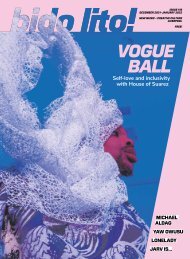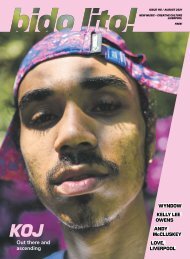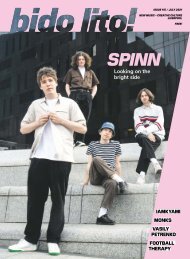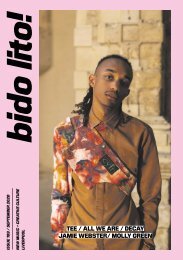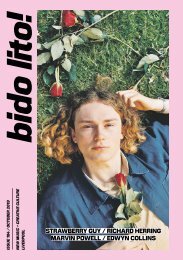Issue 113 / April-May 2021
April-May 2021 issue of Bido Lito! magazine. Featuring: PIXEY, AYSTAR, SARA WOLFF, DIALECT, AMBER JAY, JANE WEAVER, TATE COLLECTIVE, DEAD PIGEON GALLERY, DAVID ZINK YI, SAM BATLEY, FURRY HUG, FELIX MUFTI-WRIGHT, STEALING SHEEP and much more.
April-May 2021 issue of Bido Lito! magazine. Featuring: PIXEY, AYSTAR, SARA WOLFF, DIALECT, AMBER JAY, JANE WEAVER, TATE COLLECTIVE, DEAD PIGEON GALLERY, DAVID ZINK YI, SAM BATLEY, FURRY HUG, FELIX MUFTI-WRIGHT, STEALING SHEEP and much more.
You also want an ePaper? Increase the reach of your titles
YUMPU automatically turns print PDFs into web optimized ePapers that Google loves.
Thurstaston Beach - George Jones<br />
scenes, complete with new understandings of tranquility<br />
and emptiness. Photographs such as Isolation, which<br />
depicts a Manchester hotel with a single illuminated<br />
room, play with light and a strong composition to<br />
ignite a sense of loneliness, while being deeply<br />
atmospheric in its use of colour. The Past is a Foreign<br />
Country portrays another Manchester scene where<br />
a modern cityscape looms nefariously over an old<br />
industrial street. The image’s patchwork composition<br />
exposes gentrification as something palpable, layered<br />
and always in process, as well as demonstrating the<br />
precarity of history in the landscape.<br />
Expanding on human stories through a point of view<br />
that is often marginalised, Harry Arthur, Homeless in<br />
Liverpool is an image that depicts a man with the word<br />
‘rich’ written across his fingers. Here, the hand replaces<br />
the face as the traditional subject of the portrait, and<br />
the viewer is confronted with a sense of identity from a<br />
sidelined perspective.<br />
Unity Is Strength, which illustrates a mostly<br />
unpopulated Liverpudlian street decked out in flags<br />
during the 2019 Champion’s League final, aims to<br />
address the importance of togetherness during a time of<br />
separation. Underscored by a table decorated in red, this<br />
photograph is visually striking in its celebratory tone, and<br />
its evocative depiction of community spirit.<br />
“I wanted to subtly capture the smaller moments<br />
of bliss and the honest expression of Liverpool’s<br />
communities, says its photographer Oliver O’Callaghan.<br />
“It’s important to daydream and reflect on these special<br />
moments.” For this photographer, escape through<br />
imagination is a crucial theme, and is here interpreted<br />
by reflecting on past celebrations and communal events.<br />
The tenacity of this image is clear, and its outlook is equal<br />
parts nostalgic and forward thinking. When layered with<br />
commemorative flags and banners, the city street starts<br />
to represent something new, speaking to the social unity<br />
of Liverpool’s people.<br />
Cranborne, similarly, emphasises the importance<br />
of community and friendship in the city, showing three<br />
figures playing with a football in a Liverpool street. Its light,<br />
composition and feeling of being in the midst of a game,<br />
gives the image an idyllic sheen. Images like Barry, which<br />
shows a cheerful man on the Albert Dock with pigeons<br />
perching on his head and shoulder, also put an interesting<br />
twist on the traditions of photojournalism, exposing the<br />
unapologetically joyous side to Liverpool life.<br />
Amelia Jones, who describes the photograph as<br />
telling the story of a “Liverpool-born man who still lives<br />
and works in the city, is proud to be a Scouser and is<br />
happy to tell the world.” says that they hoped to show a<br />
“happier side to documentary photography”, subverting<br />
viewer expectations. “It shows that Scousers have a<br />
joyful side, and that even the birds aren’t afraid to say<br />
hello,” adds Jones. There is a familiar warmth and strong<br />
sense of playfulness to this image of the photographer’s<br />
father, which demonstrates the strength of family and<br />
relationships in the local area.<br />
The photographer of A Flicker of Hope, an image<br />
of a Black Lives Matter protest last summer, was also<br />
interested in the social histories of the landscape that<br />
rests behind the image. Some of 2020’s most powerful<br />
and dynamic imagery has come from protest and this,<br />
as a photographic diptych that is almost sculptural in the<br />
strength of its light, is no exception.<br />
Sean Tadman explains that they took the photograph<br />
on the steps of St George’s Hall: “This imposing structure<br />
– a symbol of the fortunes made from the slave trade –<br />
fuelled the notions of injustice felt by the subject as she<br />
spoke about Liverpool’s history and the oppression faced<br />
by black people today.”<br />
The image exposes how the cityscape itself can be<br />
complicit in sustaining dark political conventions: “I found<br />
it shocking when looking into the historical significance of<br />
Liverpool in relation to the slave trade and how little we<br />
in the UK are taught about it, particularly as our colonial<br />
history has so much influence upon the UK’s culture,<br />
architecture, art, and oftentimes, financial relevance on an<br />
international scale.”<br />
According to Tate Collective Producer Niamh, this<br />
image particularly captures “what has been happening<br />
in the past year”: the changes, the protests, the Black<br />
Lives Matter campaign. The photograph’s monochromatic<br />
colour scheme is a deliberate attempt to flatten the<br />
time between the Civil Rights movement of the 50s<br />
and 60s and that of the present day, demonstrating the<br />
contemporary relevance of these issues, and giving a<br />
sense of urgency to the image and its cause.<br />
Many of these images follow in McCullin’s footsteps<br />
FEATURE<br />
by exposing the histories embedded in the landscape,<br />
while demonstrating social change as being an integral<br />
part of our city’s political history. The final project is a<br />
celebration of the imagery that evolves organically from a<br />
time of constraint, as captured by local people. Speaking<br />
on behalf of Tate Producers, Laura’s assertion that the<br />
project “shows a feeling, in Liverpool, of openness”<br />
expresses the success of the project and its stories; while<br />
each image is unique and personal, they are fragments<br />
of a greater whole, contributing to a collaborative<br />
understanding of the North West through engaging with<br />
young local talent. !<br />
Words: Leah Binns<br />
Unity is Strength - Oliver O’Callaghan<br />
The works in the exhibition will be shown across<br />
Liverpool from 7th <strong>April</strong>. Tate Collective will also run<br />
several day takeovers across their social media channels,<br />
showcasing entries and the artists involved. Locations of<br />
the billboards and further information on the project can<br />
be found via the link below.<br />
tate.org.uk/tate-collective/photographing-north-west<br />
@TateCollective<br />
Tate Collective is supported by Jean and<br />
Melanie Salata with additional support from Garfield<br />
Weston Foundation, The Rothschild Foundation, and Tate<br />
Patrons.<br />
29




